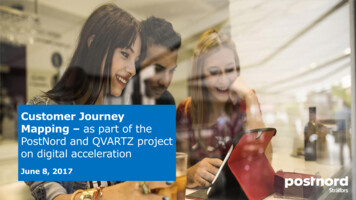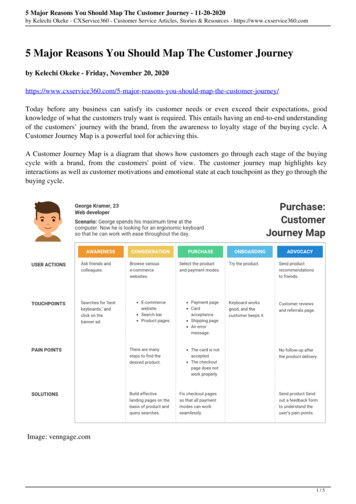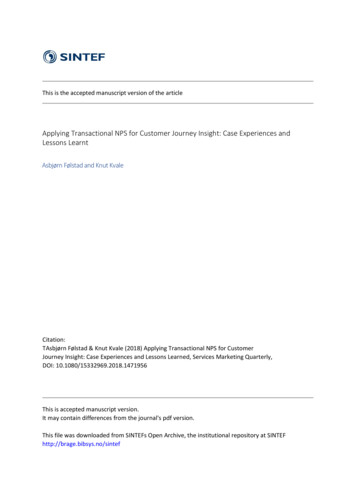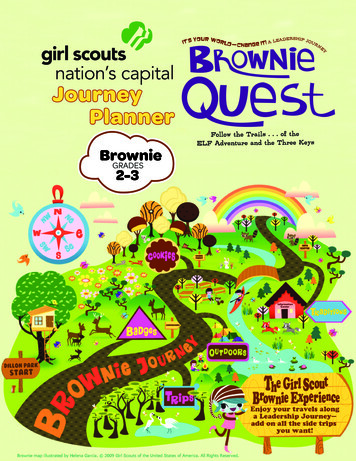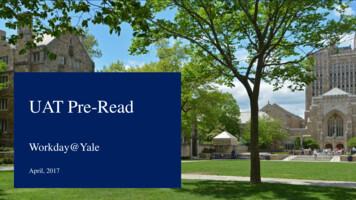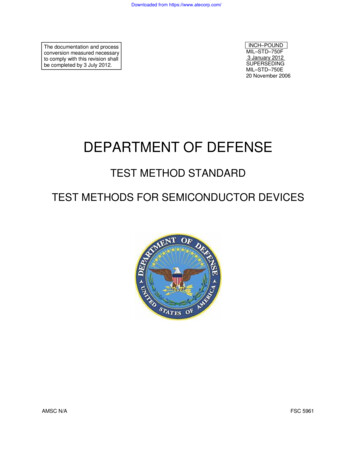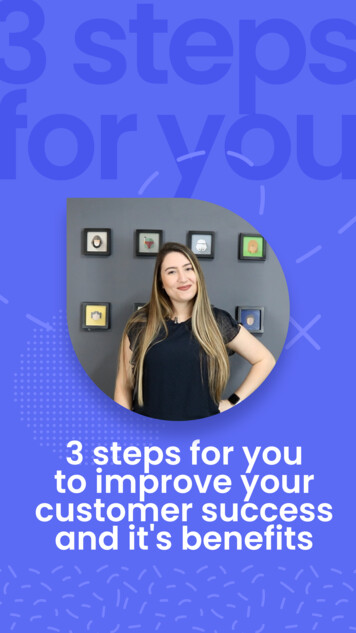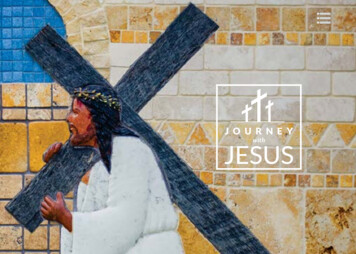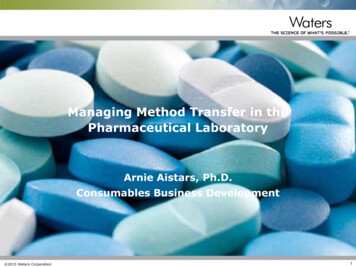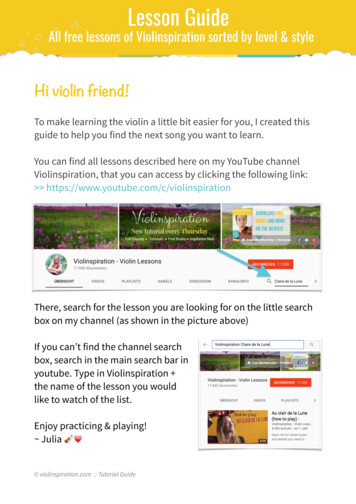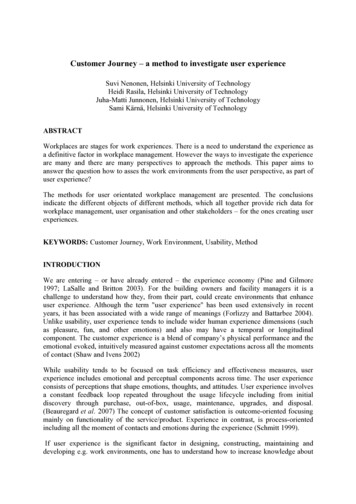
Transcription
Customer Journey – a method to investigate user experienceSuvi Nenonen, Helsinki University of TechnologyHeidi Rasila, Helsinki University of TechnologyJuha-Matti Junnonen, Helsinki University of TechnologySami Kärnä, Helsinki University of TechnologyABSTRACTWorkplaces are stages for work experiences. There is a need to understand the experience asa definitive factor in workplace management. However the ways to investigate the experienceare many and there are many perspectives to approach the methods. This paper aims toanswer the question how to asses the work environments from the user perspective, as part ofuser experience?The methods for user orientated workplace management are presented. The conclusionsindicate the different objects of different methods, which all together provide rich data forworkplace management, user organisation and other stakeholders – for the ones creating userexperiences.KEYWORDS: Customer Journey, Work Environment, Usability, MethodINTRODUCTIONWe are entering – or have already entered – the experience economy (Pine and Gilmore1997; LaSalle and Britton 2003). For the building owners and facility managers it is achallenge to understand how they, from their part, could create environments that enhanceuser experience. Although the term "user experience" has been used extensively in recentyears, it has been associated with a wide range of meanings (Forlizzy and Battarbee 2004).Unlike usability, user experience tends to include wider human experience dimensions (suchas pleasure, fun, and other emotions) and also may have a temporal or longitudinalcomponent. The customer experience is a blend of company’s physical performance and theemotional evoked, intuitively measured against customer expectations across all the momentsof contact (Shaw and Ivens 2002)While usability tends to be focused on task efficiency and effectiveness measures, userexperience includes emotional and perceptual components across time. The user experienceconsists of perceptions that shape emotions, thoughts, and attitudes. User experience involvesa constant feedback loop repeated throughout the usage lifecycle including from initialdiscovery through purchase, out-of-box, usage, maintenance, upgrades, and disposal.(Beauregard et al. 2007) The concept of customer satisfaction is outcome-oriented focusingmainly on functionality of the service/product. Experience in contrast, is process-orientedincluding all the moment of contacts and emotions during the experience (Schmitt 1999).If user experience is the significant factor in designing, constructing, maintaining anddeveloping e.g. work environments, one has to understand how to increase knowledge about
user experiences in work environments. It is essential to shift the focus from workingprocesses towards employee experiences. The question arises: How to assess the workenvironments from the user experience perspective?To answer this question this paper proposes a methodology for assessing the experience ascustomer journey. The methodology is built in a gross-disciplinary manner: the postoccupancy evaluations (Barrett and Baltry 2003), usability walk-through audits (e.g. Nenonenand Nissinen 2005; Riihiaho 2002) and service process evaluations (Gummesson andKingman-Brundage 1992) are combined with insight from customer journey (Christopher,Payne and Ballantyne 1991). It is suggested that these analysis could enable to understanduser’s experiences, activities and factors, which are significant for the usability.POST OCCUPANCY EVALUATION, USABILITY WALKTHROUGH, CRITICALINCIDENT TECHNIQUE AND CUSTOMER JOURNEYFacility oriented approach – Post Occupancy evaluationPost-Occupancy Evaluation - POE (Preiser et al. 1988) is the process of systematic collectionof data on occupied built environments, analysis of these data and comparison withperformance criteria. POE’s are particularly aggravated to the users’ needs, preferences andexperiences. It assesses how well buildings match users' needs, and identifies ways toimprove building design, performance and fitness for purpose. Building users are all peoplewith an interest in a building - including staff, managers, customers or clients, visitors,owners, design and maintenance teams, and particular interest groups such as the disabled. Ituses the direct, unmediated experiences of building users as the basis for evaluating how abuilding works for its intended use.POE is also a formal way of determining whether a recently occupied or remodeled buildingis performing as was intended in its programming and design (Horgen and Sheridan 1996).Post Occupancy Evaluation can be used for many purposes, including fine tuning newbuildings, developing new facilities and managing problem buildings. Organisations also findit valuable when establishing maintenance, replacement, purchasing or supply policies;preparing for refurbishment; or selecting accommodation for purchase or rent. (Preiser 1989.)Indicators for success of the building are for instance a high occupancy level, a positiveappraisal by occupants and visitors, and easy to let (low vacancy rate, small number ofmovements). Indicators for failure are for instance complaints of users, negative comments ofexperts, high running costs or a burglary rate above average. Over the years there is agrowing awareness of the importance of Total Building Performance Evaluation, alsoincluding technical aspects, building physics and costs (Preiser and Schramm 1998).There are numerous methods of data-collection such as questionnaires, individual and groupinterviews, behavioural mapping, technical assessment tools and mathematical models, eachwith its own pros and cons. World-wide sound instruments such as the Real Estate Norm,Serviceability Tools and Methods and other scaling techniques are used in order to measurefunctional aspects such as usefulness, accessibility, health, safety, and flexibility. (Voordt1999)
Some critics claim that such assessments concentrate too much on technical aspects of thebuildings. It is focusing on building, giving feedback instead of feed-forward and needsadditional methods to achieve the user. (Alexander et al. 2005; Voordt 1999)Usability oriented approach – Usability walkthroughA CIB Task Group 51 “Usability of buildings” has been created to apply concepts ofusability, to provide a better understanding of the user experience of buildings andworkplaces. Usability is defined as the “ .effectiveness, efficiency and satisfaction withwhich a specified set of users can achieve a specified set of tasks in a particular environment”According to this definition, a product’s usability is determined by 3 key factors: Effectiveness – whether users can achieve what they want to do with the product Efficiency – how long it takes them to achieve it Satisfaction – their feelings and attitude towards the productThe first level of the usability decomposition is what is called usability attributes. Usabilityattributes are precise and measurable components of the abstract concept that is usability.Usability attributes include e.g. that systems are easy and fast to learn, efficient to use, easyto remember, allow rapid recovery from errors and offer a high degree of user satisfaction.It also means bringing the user perspective into focus. The term usability describes whetheror not a product is fit for a specific purpose. Usability, or functionality in use, is concerningthe buildings ability of supporting the user organizations economical and professionalobjectives. (Jensø et al. 2004)The methods to assess usability are developed mostly in information and communicationtechnology. However they can be applied to physical built interfaces and infrastructure aswell as to virtual interface and infrastructure. Heuristic Evaluation (Nielsen and Mack 1994)identifies usability problems early in the design phase. One can provide mock-ups, in order toavoid usability problems. Formal Usability Inspection can be additional for mock upassessment. Riihiaho (2000) describes the usability walkthrough as the method, which guidesthe analysts to consider users’ mental processes in detail instead of evaluating thecharacteristics of the actual interface. The method can be used also in very early phase in thedesign process to evaluate designers’ preliminary design ideas. On the other hand the contextof the tasks and the users’ characteristics must be well specified so that the users’ mentalprocesses will be articulated. Cognitive Walkthrough (Rowley and Rhoades 1992); (Whartonet. al. 1994) is a task oriented usability inspection method. Its focus is on ease of learning.Cognitive walkthrough is based on a theory of learning by exploration according to whichusers try to infer what to do next using cues that the system provides.Pluralistic Walkthrough (Bias 1991) looks into how users react in different situations. Thepluralistic usability walk-through session include participants from several groups: the users(present or potential) of the workplace, system developers like architects, designers andconstructors and usability experts. It is best used in the early stages of development, as thefeedback garnered from pluralistic walkthrough sessions is often in the form of userpreferences and opinions. Together the participants gather information about the usability by
inspecting the workplace. In the end of the session the whole group discusses the findingsthey have made.Feature Inspection (Nielsen and Mack 1994) aims to find out if the feature of a product (e.g.meeting rooms) meets the users need and demanding. This method is used at its best in themiddle stages of development. At this point, the functions of the product and the features thatthe users will use to produce their desired output are known. This can be enriched withconsistency inspections, which look for consistency across multiple products from the samedevelopment effort. Guidelines and checklists help ensure that usability will be considered ina design. Usually, checklists are used in conjunction with a usability inspection method.(Nielsen 1993).Usability assessing methods are interested in understanding the development of interfacefrom the user perspective. It is widening the perspective from functionality to functionality inuse. However the logic for usability walkthrough has to be approached more specific way.Process and experience oriented approach – Critical Incident Technique and CustomerJourneyWalk-through audits have been used also in service industries, mostly in hospitality industry(see Fitzsimmons and Fitzsimmons 2004; Fitzsimmons and Maurer 1991). The serviceprocess audits have some insight that lack from e.g. post occupancy evaluation. This insightis related to the fact that service process audit literature notices the process nature of servicesand starts analysis by defining the processes that are carried out in certain premises. AsKoljonen and Reid (2000) put it:An understanding of any professional service creation and delivery system beginswith a comprehensive description of the client service process.A basic method to understand and to describe service processes is service blueprinting. Themethod was introduced by Shostack already in 1984. In service blueprint the serviceprocesses and interactions are visualized as a flowchart (see for example Koljonen and Reid2000). This approach has some disadvantages; first, it typically looks at the processes ratherfrom company than customer perspective. Second, the blueprint illustrates only theobservable actions or events (Kingman-Brundage 1989).Other methods for analyzing service processes are service mapping (Kingman-Brundage1989; Gummesson 1993; Gummesson and Kingman-Brundage 1992) and sequential incidenttechnique (SIT) (Stauss 1993; Stauss and Weinlich 1995). The first is, as service blueprinting,more company focus whereas SIT is more customer focused.Sequential incident technique draws from critical incident technique (CIT) in which thecustomer is asked to describe those moments in service process that were in some respectexceptional – either in good or in bad. Then the data is classified into different types ofexperiences with content analysis. (Bitner et al. 1990) For our purposes the approach has twolimitations; first the process dimension is not clear and second the normal incidents areexcluded from the analysis. Sequential incident technique bypasses these problems. It looksat entire processes and includes also those incidents that are not exceptional. As Stauss andWeinlich (1995) state: “The fundamental purpose of the method is to record all incidentscustomers perceive in a specific service transaction sequentially in the course of the
consumption process.” The first step is to construct a “customer path diagram” (compare withblueprinting). This diagram shows the typical path customer follow when involved in someservice process. Suggested methods for data gathering are single interviews, groupinterviews, surveys and observation. The aim is to understand what customers typically doduring the service process (Stauss and Weinlich 1995). This is called customer journey.The customer journey is the cycle of the relationship/buying interaction between the customerand the organisation (“what we put our customers through if they wish to, and do, do businesswith us”). It is a visual, process-oriented method for conceptualising and structuring people’sexperiences. Customer-journey means the customer’s transition from never-a-customer toalways-a-customer. This has been described by others (Christopher, Payne and Ballantyne 1991)as a customer staircase or ladder. On this journey the value of customers will change. Thesemaps take into account people’s mental models (how things should behave), the flow ofinteractions and possible touch points. They may combine user profiles, scenarios and userflows and reflect the thought patterns, processes, considerations, paths and experiences thatpeople go through in their daily lives.The customer life cycle usually starts when the customer wants or needs a product or serviceand will continue to the point where the product is reclaimed, redeemed or renewed. Theorganisation’s aim is to manage this journey in such a manner that maximises value both forthe customer and for the organisation. Different authors use different amount of phases incustomer journey. They are summarised in Table 1.Table 1. Phases in customer journeyPhases from customer to commitmentperspectivePhases fromperspectivecustomerexperiencePhasesfromprocess perspectiveSuspect - could the customer fit tocompany’s target market profileNeed - I’m considering a purchase – whoshould I approach?OrientationProspect - customer fits the profile and isbeing approached for the first timeEnquire - I make general enquiries topossible suppliers.ApproachFirst-time customer - customer makes firstpurchaseApproach - I decide to make morespecific enquiries to a selected fewActionRepeat customer - customer makes morepurchasesRecommendation - They makerecommendations and/or send proposalsDepartMajority customer - customer selects yourproduct/company as supplier of choicePurchase - I decide to purchase and placemy order with one supplierEvaluationLoyal customer - customer is resistant toswitching suppliers; strong attitudeExperience - They supply and I use theproduct or service.Advocate - customer generates additionalProblem - I have a problem that is
Phases from customer to commitmentperspectivePhases fromperspectivecustomerexperiencereferral currencyreported to and handled by the supplier.Phasesfromprocess perspectiveReconsider - I’m considering purchasingsomething else – should I go back?The Customer Journey is a systematic approach designed to help organisations understandhow prospective and current customers use the various channels and touch points, how theyperceive the organisation at each touch point and how they would like the customerexperience to be. This knowledge can be used to design an optimal experience that meets theexpectations of major customer groups, achieves competitive advantage and supportsattainment of desired customer experience objectives.When the customer path or user journey is understood, the SIT moves on to second phase –namely assessing the customer experience during this path. This is done with interviews orsurveys. After the entire data has been collected, it may be then analyzed. If they survey isconducted, then statistical methods are applicable. If the customer experience is studied byinterviews more qualitative methods are applicable. (Stauss and Weinlich 1995)METHODS IN INVESTIGATION OF USABILITY OF BUSINESS PARKSThe usability of business parks can be approached by methods presented above. One way todefine Business Park itself can be defined either in a product orientated way “A landscapedarea containing high tech, other amenities for business purposes, as distinct from high-techpark or a science park. Building density is lower than would be usual in a traditionalindustrial estate. Business Parks are preferentially located where motorway, rail and airportcommunications are within a short distance.” Narains (2006) or in a process orientated wayas:“ Collection of companies of more or less related activities, in close proximity, exploitingthe benefits of synergy” (Promitheas 2006)Business park consist on several buildings, which of course provides possibilities to use postoccupancy evaluation in a relevant way, because the quantitative data is easy to collect. Postoccupancy evaluation provides also comparative data if the surveys are conducted before andafter the change, e.g. removal.Usability walkthrough method in business parks rises up a question, who is the user. There isneed to define different user groups. The tenant organizations in the business parks form oneuser group. Their customers are important users too. Thirdly the service providers in thebusiness park are one user group. The usability is different for different user groups.Critical incident technique concentrates in service processes in the business park – thismethod is relevant when understanding business park in process orientated way. The methodallows information especially about the service processes within a business park and indicatesthe service blueprints in the service environment.
Customer journey in Business Park allows researcher to investigate the user experience as apart of the customer journey process. This differs from usability walkthrough method in away that in customer journey one defines the moments of relationships during the customerjourney. Usability walkthrough concentrates on usability of the functions of the environment.Table 2 summaries the characteristics of different methods. Together they provide a completeillustration of the phenomena as well as rich data.Table 2. Summary of different methodsMethodResearch ObjectResearch TechniquesPresentation of resultsPost occupancyevaluationBuildingSurvey - ,usability offunctions of thebuildingsParticipative interviews during thewalkthrough (discussion duringwalkthrough) or after the walkthrough(silent walkthrough)User paths and mapsObservationsQualitative incidenttechniqueService processCustomerjourneyProcessInterviews – qualitativeObservationsInterviews – qualitativeDescriptions of transactions– process descriptions,service pathsCustomer journey mapillustrationsSurveys - quantitativeProcess descriptionsDiagramsCONCLUSIONSThis paper described the methods to assess usability of work places. The Post OccupancyEvaluation (POE) method is focusing on building as object instead of process. Usabilitywalkthrough is focusing on qualities of different functions within a building, its attributes.Customer journey provides data about the processes and user experiences in the workenvironment. These different orientations provide a possibility to gather rich data from thework environment and weight the customer experience from different angels.
The tangible and intangible elements of user experience are both measurable. The advantageof the methods presented in this article is that they can uncover those small details that affectthe workplace experience – sometimes to a really great extent. Still they also allow increasingunderstanding in more general level. Nevertheless, the usage of different methods demandsmore investigations in order to provide sufficient new data for evaluating and developing userexperiences in the workplaces.REFERENCESAlexander, K., Fenker, M., Granath, J.Å., Haugen, T., Nissinen, K. (2005) Usableworkplaces: action research. Proceedings. CIB 2005, Combining Forces – AdvancingFacilities Management & Construction through Innovation Series, pp. 389-399. 1316.6.2005, Helsinki, Finland.Barrett, P., Baldry, D. (2003) Facilities Management – Towards Best Practice, 2nd edition.Blackwell Science Ltd. Oxford, 2003. ISBN-0-632-06445-5.Beauregard, R., Younkin, A., Corriveau, P., Doherty, R., Salskov, E. (2007) Assessing theQuality of User Experience. Intel Technology 11i1/8-quality/Bias, R. (1991) Walkthroughs: Efficient collaborative testing. IEEE Software 8(5), pp. 94–95.Bitner, M.J.; Booms, B. H., Stanfield Tetreault, M. (1990) The Service Encounter:Diagnosing Favorable and Unfavorable Incidents, in: Journal of Marketing, Vol. 54, No. 1 (,pp. 71-84.Fitzsimmons, J. A. and Fitzsimmons M. J. (2004) Service. management: Operations,Strategy and Information Technology, McGraw-Hill: London.Fitzsimmons, J. and Maurer, G.B (1991) A walk-through audit to improve restaurantperformance. The Cornell HRA Quarterly, Vol. 31 No.4, pp.95-99.Forlizzi, J. and Battarbee, K. (2004) Understanding Experience in Interactive Systems, inProceedings of the 2004 Conference on Designing Interactive Systems: Processes Practices,Methods, and Techniques, pp. 261–268.Gummesson, E. and Kingman- Brundage, J. (1992) Service Design and Quality: ApplyingService Blueprinting and Service Mapping to Railroad Services, in: Quality Management inServices, P. Kunst and J. Lemmink, eds., Van Gorcum, Maastricht, pp. 101-114.Gummesson, E. (1993) Quality Management in Service Organizations. International ServiceQuality Association, ISQA, St. John’s University, New York, NY.Jensø, M., Hansen, G.K. and Haugen, T.I. (2004) Usability of buildings: Theoreticalframework for understanding and exploring usability of buildings. 18.10.2004.Horgen, T. and Sheridan, S. (1996) Post-occupancy evaluation of facilities: a participatoryapproach to programming and design Facilities Vol. 14 No. 7/8 pp.16 – 25.
Kingman-Brundage, J. (1989) ‘The ABC’s of service system blueprinting’, in M.J. Bitner andL.A. Crosby (Eds.) Designing a Winning Service Strategy, Chicago: American MarketingAssociation.Koljonen E.L.-P.L. and Reid R.A. (2000) Walk-through audit provides focus for serviceimprovments for Hong Kong Law Firm. Managing Service Quality. Vol. 10 No. 1, pp. 32-46.LaSalle, Diana and Terry A. Britton (2003) Priceless. Turning Ordinary Products intoExtraordinary Experiences. Boston: Harvard Business School Press.Narains (2006) http://narains.com/glossary.htm. assessed: 16.8.2006.Nenonen, S. and Nissinen, K. (2005) Usability walkthrough Usability Walkthrough inWorkplaces – What, how, why and when. Proceedings. CIB 2005, Combining Forces –Advancing Facilities Management & Construction through Innovation Series, Vol IV, pp.413-422. 13-16.6.2005, Helsinki, Finland.Nielsen, J. (1993) Usability Engineering. Academic Press, San Diego.Nielsen J. and Mack R.L. (ed) (1994) Usability inspection methods. Wiley, New York, USA.Christopher, M, A Payne and Ballantyne, D. (1991) Relationship Marketing, Oxford,Butterworth-Heinemann.Pine J. and Gilmore J. (1999) The experience economy: Work is theatre every business is astage. Harvard business press. Boston. USA.Preiser, W.F.E. (Ed.) (1989). Building Evaluation. New York, NY: Plenum.Preiser, W. F.E and Schramm U. (1998). Building Performance Evaluation. Time-SaverStandards for Architectural Data, 233-238.Preiser, W.F.E., H.Z. Rabonowitz, E.T. White (1988), Post-occupancy Evaluation. NewYork; Van Nostrand Reinhold Company.Promitheas (2006) http://www.promitheas.com/glossary.php. assessed: 16.8.2006.Riihiaho, S. (2002) The Pluralistic Usability Walk-Through Method, in: Ergonomics indesign, Vol. 10, No. 3, pp. 23–27.Rowley, D.E and Rhoades, D.G. (1992) The Cognitive Jog through: A Fast-Paced UserInterface Evaluation Procedure., Proceedings of the Proceedings of the SIGCHI conferenceon Human factors in computing systems, ACM Press, Monterey, California, United States, pp.389-395.Schmitt, B. (1999) “Experiential Marketing” Journal of Marketing Management, 15(13), pp.53–67.Shaw, C. and Ivens, J. (2002), Building Great Customer Experiences, Palgrave Macmillan.Shostack, G.L. (1984). Designing services that deliver. Harvard Business Review 62, pp.133-140. 61.
Stauss, B. (1993) "Using the critical incident technique in measuring and managing servicequality", in Scheuing EE, Christopher WF (eds) The service quality handbook, American.Management Association, New York.Stauss, B. and Weinlich, B. (1995) Process-oriented measurement of service quality byapplying the sequential incident method", Tilburg, The Netherlands.Voordt, D.J.M. van der (1999) “Objectives and methods of POE”. Paper presented at FAU,Sao Paulo, Brasil, August 1999.Wharton, C., Rieman, J., Lewis, C., and Polson, P. (1994) The cognitive walkthroughmethod: A practitioner's guide. In Nielsen, J., and Mack, R. L. (Eds.) Usability inspectionmethods, pp. 105-140. New York, NY: John Wiley & Sons.
customer journey. The methodology is built in a gross-disciplinary manner: the post occupancy evaluations (Barrett and Baltry 2003), usability walk-through audits (e.g. Nenonen and Nissinen 2005; Riihiaho 2002) and service process evaluations (Gummesson and Kingman-Brundage 1992) are combined with insight from customer journey (Christopher,
